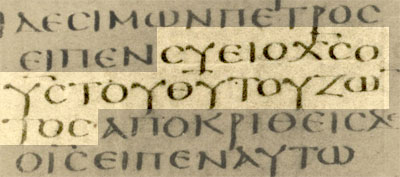I recently created this meme for the Unfundamentalist Christians Facebook page:

The intent of this picture was to refute the silly notion that replacing “Christ” with an “X” is part of a sinister plot against Christianity.
The truth of the matter is that abbreviating nomina sacra (sacred names) is a tradition that dates to the earliest days of Christianity. To preserve space and save valuable writing resources, scribes often used such abbreviations for references to God and Christ, usually by writing only the first and last letter of a word with a bar across the top.
In the meme above I included a transcription from Codex Sinaiticus, a 4th century manuscript of the Bible. Here’s the actual text from Matthew 16:16b as it appears in Sinaiticus:

In this verse we find three nomina sacra: ΧC, short for χριστὸς (Christ); ΥC, short for υἱὸς (son); and ΘΥ, short for θεοῦ (God). If you’re reading carefully you’ll notice that the letters in the abbreviations don’t seem to quite match up with the letters from the full word. That’s because Siniaticus is written entirely in uppercase letters, also known as uncials. Just as in English, many of these letters change form from uppercase to lowercase. In the nomina sacra above, C is an uppercase sigma (ς) and Υ is an uppercase upsilon (υ).
But enough with the Greek lesson. The important point is that the Greek letter X has been used as a substitute for the name of Christ since Christians started writing the texts of the Bible. It’s an expedient shortcut devoid of ill intent and in line with a long tradition of Christian scribal practice.
 Dan Wilkinson
Dan Wilkinson
Dan is the Executive Editor of the Unfundamentalist Christians blog. He is a writer, graphic designer and IT specialist. He lives in Montana, is married and has three cats.
Leave a Reply